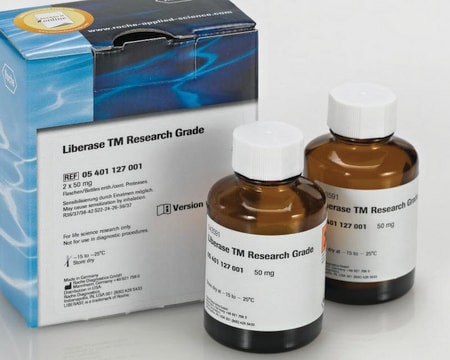추천 제품
생물학적 소스
Bacillus polymyxa (dispase)
Bacillus sp. (thermolysin - Bacillus thermoproteolyticus)
Clostridium histolyticum (collagenase)
Quality Level
설명
high Thermolysin concentration
형태
lyophilized
포장
pkg of 10 mg (05401135001 [2 x 5 mg])
pkg of 100 mg (05401151001 [2 x 50 mg])
제조업체/상표
Roche
파라미터
35-37 °C optimum reaction temp.
기술
tissue processing: suitable
최적 pH
7.4
저장 온도
−20°C
일반 설명
애플리케이션
특징 및 장점
- Maximize viability and yield of isolated cells
- Count on higher specific activity of the enzyme blend
- Obtain higher experimental reproducibility
- Increase safety
제조 메모
Working concentration: Liberase Research Grade Enzyme Working Concentration:
Liberase enzymes have significantly higher specific activities than traditional collagenases. This means that the working concentration of Liberase Research Grade Purified Enzymes, expressed in mg/ml, will be lower than that of traditional collagenase.
When the application is on the Roche list of applications at www.collagenase.com, use the Liberase Research Grade concentration recommended for that application.
When the application is not included on this list, first use Liberase TM Research Grade at a concentration of 0.08–0.28 Wünsch units/ml.
The goal is to determine the best starting concentration of Liberase Research Grade Enzyme Blends. This is a starting point, and the final concentration may vary due to differences in procedure and lot-to-lot differences in traditional collagenase.
Collagenase Working Concentration:
Multiply your previous collagenase working concentration (mg/ml) by its specific activity (Wünsch units/mg, [as determined above]), to obtain Wünsch units/ml. To determine how much Liberase Research Grade Enzyme Blend to use, first multiply your collagenase working concentration (in Wünsch units/ml) times the total volume of your working enzyme solution to obtain the total collagenase activity needed (Wünsch units). Divide the total collagenase activity required by the Liberase Research Grade stock concentration ( “Reconstitution and Storage”). This indicates how many milliliters of Liberase Research Grade Enzyme Blend stock solution to use in your working enzyme solution.
Storage conditions (working solution): Store unused stock solution in single-use aliquots at -15 to -25 °C. For further information on product stability please visit the Roche Liberase Enzyme website at www.collagenase.com.
Note: Avoid repeated freezing and thawing!
재구성
Reconstitute the entire vial. Do not weigh individual aliquots of the lyophilizate. The introduction of moisture into the vial results in a decline in enzymatic activity.
Place vial on ice to rehydrate the lyophilized enzyme.
Gently agitate the vial at 2 to 8 °C until enzyme is completely dissolved (max. 30 min).
Depending on the type of tissue-dissociation buffer used to dissolve Liberase Research Grade Purified Enzyme Blends, slight precipitations may be observed which readily dissolve in the diluted working solution and have no influence on enzyme activity.
Remove an aliquot of the stock solution to prepare the working solution.
Reconstitution volume
2 ml (1 vial with 5 mg–10 mg pack size), 10 ml (1 vial with 50 mg–100 mg pack size)
Collagenase Wünsch (units/ml)
13 (1 vial with 5 mg–10 mg pack size), 26 (1 vial with 50 mg–100 mg pack size)
Total Collagenase concentration [mg/ml]
2.5 (1 vial with 5 mg–10 mg pack size), 5.0 (1 vial with 50 mg–100 mg pack size)
기타 정보
법적 정보
신호어
Danger
유해 및 위험 성명서
Hazard Classifications
Eye Irrit. 2 - Resp. Sens. 1 - Skin Irrit. 2 - STOT SE 3
표적 기관
Respiratory system
Storage Class Code
11 - Combustible Solids
WGK
WGK 1
Flash Point (°F)
does not flash
Flash Point (°C)
does not flash
시험 성적서(COA)
제품의 로트/배치 번호를 입력하여 시험 성적서(COA)을 검색하십시오. 로트 및 배치 번호는 제품 라벨에 있는 ‘로트’ 또는 ‘배치’라는 용어 뒤에서 찾을 수 있습니다.
이미 열람한 고객
문서
Enzyme Explorer Key Resource: Collagenase Guide.Collagenases, enzymes that break down the native collagen that holds animal tissues together, are made by a variety of microorganisms and by many different animal cells.
관련 콘텐츠
Collagenase Guide.Collagenases, enzymes that break down the native collagen that holds animal tissues together, are made by a variety of microorganisms and by many different animal cells.
자사의 과학자팀은 생명 과학, 재료 과학, 화학 합성, 크로마토그래피, 분석 및 기타 많은 영역을 포함한 모든 과학 분야에 경험이 있습니다..
고객지원팀으로 연락바랍니다.












![[Leu15]-Gastrin I human ≥95% (HPLC)](/deepweb/assets/sigmaaldrich/product/structures/153/342/d4cb3dd7-13f1-46cf-8d1f-3907a5de7a83/640/d4cb3dd7-13f1-46cf-8d1f-3907a5de7a83.png)
